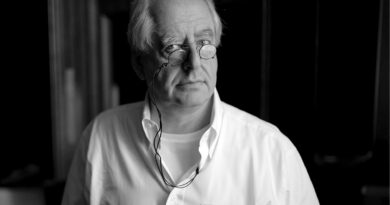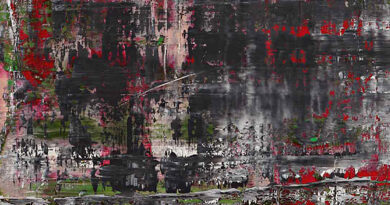do ho suh: home / an area for declarations of identity and difference
by MÜMTAZ SAĞLAM
Do Ho Suh actually develops a reactionary approach that creates a display area centered on privacy and public exposure. His work thus associates with contemporary psych-social issues and concepts by working along an awareness of architectural theories, suggestions and fictions. Moreover, such a depiction also reveals common cultural and psychic associations as a layered and comparative topology. Indeed, the use of translucent fabrics employed by Do Ho Suh becomes an exposed covering that negates the separation of interiors and exteriors. This effect, which both alienates, unnerves and invites viewers to explore the artist’s work, is also a sign of conceptual sophistication and continuity.

Do Ho Suh, Home within Home, 2019, polyester fabric, stainless steel,115.32 x 128.19 x 124.78 inches. © Do Ho Suh. Courtesy the artist and Lehmann Maupin, New York, Hong Kong, Seoul, and London. [https://www.lehmannmaupin.com/artists/do-ho-suh/featured-works?view=slider#5]
Do Ho Suhis a Korean sculptor and artist known for his fictional structures that reenact the houses he has lived in with meticulous arrangements of domestic objects, covered with translucent polyester.[i] The concept of a home as a physical and spiritual reality is here used as a potent symbol that implies cultural difference, a bodily compromise, or resistance.[ii]
Despite their robust steel construction, these homes; interrelated to concepts and problems such as migrant, locale and belonging; nevertheless appear quite clear, light and spacious thanks to their transparent and empty structures. They even enable interlinked mental navigation with parodic attachments such as staircases and corridors. Sometimes, the entire space assumes a ghostly appearance with ceiling-bound arrangements of an uncanny aesthetic sensibility.
With these depictions, Do Ho Suh actually develops a reactionary approach that creates a display area centered on privacy and public exposure. His work thus associates with contemporary psych-social issues and concepts by working along an awareness of architectural theories, suggestions and fictions. Moreover, such a depiction also reveals common cultural and psychic associations as a layered and comparative topology. Indeed, the use of translucent fabrics employed by Do Ho Suh becomes an exposed covering that negates the separation of interiors and exteriors. This effect, which both alienates, unnerves and invites viewers to explore the artist’s work, is also a sign of conceptual sophistication and continuity.
Suh, who conducts installations that connect to his life between different locations, cities and countries he has lived in; imbues his ghostly scenes with spatial experiences of mental and physical intensity. With his trademark use of transparent effects, the artist highlights the transformative and destructive force inherent in cultural change and weakened locational experiences.
As seen in his 2016 installation Home Within Home, the artist tries to narrate the persistence of memories, which have kept him company throughout his life with synchronous conflicts and associations.[iii] Thus, the overall theme of Suh’s work has great potential to cause uncanny assumptions that grow hazy as they interlink with real life, and transform into a permanent void sensed across a personal plane of space-time.[iv]
do ho suh / the home as a product of transformative architectural practice
The image of the house is a constant concept and problem in Suh’s approach to art. It is a mute and symbolic form that keeps a psychology of transience alive, woven together by cultural and geographic codes, an awareness of its own difference. Its transparent effects, a key element in guiding the viewer’s gaze, is in fact a construct that solidifies and strengthens the formal reality of love, and the entailing paradigm of narrative. This effect, which simultaneously expresses inter-cultural conflict and resolution, is also an important element that determines the installation’s conceptual groundwork.
In this respect, the home emerges as an embodiment of a gaze that investigates the possibilities of a detailed narrative; discusses the possibilities of a formal language – a declarative incident that transgresses ordinary relations of representation as a robust architectural metaphor. At this junction, an architectural fantasy of creativity and structuring begins to develop, enmeshed with the installations’ arrangements of objects.
Suh’s re-design of domestic details and objects as structural elements extends the concepts behind idea of home into a rich and more perceptible spiritual reality. Furthermore, Suh’s mobile, transient and lightweight sculptures, used to demarcate an area, have an overall effect that creates a holistic, uncanny and conflicting experience. Suh thus constructs a conceptual language that presents a new form of reality, and bolsters the depiction of the installation area with stitching and embroidery techniques native to his part of Asia. Especially with re-imaginings of domestic objects, he adds new extensions to this phantom fictional narrative, and carries out radical interventions.
a display area for declarations of difference
Since 1998, Do Ho Suh has been enriching a permeable but impossible world of images with his polyester cloth sculptures, with his installations, and with his depictions of hallways, stairways and gates.[v] The locations, set up in 1:1 scale and realistic dimensions, gain an unsettling and threatening openness with their translucent wall illusions. This veil-draped, phantom depiction of reality is doubtlessly striking to view.[vi] Bolstered with psychic readings; setting an example for issues of public and private space and interiors/exteriors, this depiction is almost self-threatening with its fragile structure and its inherent sense of uncertain lightness.
By designating a display area for cultural and spiritual conflicts, with an experience-based approach, Do Ho Suh’s unique and striking designs present an unprecedented visual depiction of home. (Translated by C.M. Kösemen)
Mümtaz Sağlam, Copyright © 2022 / All Rights Reserved.
see. https://saglamart.com/do-ho-suh-the-house-as-an-act-of-deconstructive-provocation
[i] Do Ho Suh (b. 1962, Seoul, Korea; lives and works in London, United Kingdom) works across various media, creating drawings, film, and sculptural works that confront questions of home, physical space, displacement, memory, individuality, and collectivity. Suh is best known for his fabric sculptures that reconstruct to scale his former homes in Korea, Rhode Island, Berlin, London, and New York. Suh is interested in the malleability of space in both its physical and metaphorical forms, and examines how the body relates to, inhabits, and interacts with that space. He is particularly interested in domestic space and the way the concept of home can be articulated through architecture that has a specific location, form, and history. For Suh, the spaces we inhabit also contain psychological energy, and in his work he makes visible those markers of memories, personal experiences, and a sense of security, regardless of geographic location. [https://www.lehmannmaupin.com/artists/do-ho-suh/biography]
[ii] Do Ho Suh uses a translucent red polyester fabric for the stair installations, which contrasts with the solidity of the architectural structure. He emphasizes a local and traditional connection with the color he named Ottoman Red, which he used in his first staircase installation, which was exhibited at the 8th Istanbul Biennial in 2003. The insistent choice of red fabric in these arrangements uses it as a way to remove the building from its original context and to perceive the recognizable floating structure as if it were in a dream setting. See [https://delood.com/archive/art-archive/do-ho-suh-staircase-iii/]
[iii] Home within Home, an installation in which the viewer simultaneously stays in and out or wanders under, includes a radical installation proposal. See. Do Ho Suh, “Home within Home”, 2013, Installation with Metal Construction and Polyester Fabric, 602.3×505.1×510.6 cm. [www.saic.edu.2018]
[iv] See. Mark W. Scala, Do Ho Suh, Specimens, (PDF) [https://fristartmuseum.org/wp-content/uploads/do_ho_suh_gallery_guide.pdf]
[v] Do Ho Suh, first named Reflection, in 2004, this sculptural arrangement made of polyester fabric and stainless steel sheet and pipe of varying sizes consists of a replica of the door of the house where the artist spent his childhood in South Korea. Two fabric planes positioned against each other form a mirror image of each other. Another version of this work was exhibited in New York: See. Do Ho Suh, Reflection, Solo Exhibition, 29 November 2007 – 2 February 2008, Lehman Maupin Gallery, Chriystie Street, New York.
[vi] See. Do Ho Suh, Seoul Home/Seoul Home/Kanazawa Home/Beijing Home/Pohang Home/Gwangju Home, 2012-present installation view, Perfect Home, 21st Century Museum of Contemporary Art, Kanazawa, Japan, 2012–2013. [https://www.lehmannmaupin.com/artists/do-ho-suh#inquire]



